Learning through research: a Serbian tradition Teach article
Srdjan Verbic tells the story of the Petnica Science Center, which brings enthusiastic students (and teachers) from across Europe to a village in Serbia, where together they discover the joy and fascination of science.
There is one outcome of teenage research projects that is often undeservedly overlooked. Research not only allows self-directed learning, the fostering of critical thinking skills and thinking outside the ‘classroom science’ box, but also enables young people to gain very important social skills: communication, teamwork and listening to one anothers’ ideas.
We all enjoy spending time in dynamic, stimulating surroundings and teenagers are no different. It is not easy being a teenage scientist these days, and it is particularly hard in the Balkans. Difficult times, lack of materials and the unpopularity of science amongst school friends prevent those interested in science from taking it further. This is where centres of excellence come in – attracting and motivating young people to take on a collaborative research project outside the standard school curriculum.
Many centres of this kind proliferated throughout Europe, in particular in Eastern Europe, in the 1980s. Unfortunately, a great majority of them did not have the ‘critical mass’ to maintain their operation. However, one centre, established in former Yugoslavia (now in Serbia), has survived, developing its programmes and attracting more visitors each year.
Twenty-five years ago, in a village called Petnica, 100 kilometres south-east of Belgrade, an unusual science education centre was founded and soon became a hideaway for many rebellious secondary-school and university students from all over Yugoslavia. The attractive landscape and rich natural resources, such as a canyon, caves and archaeological sites, caught these students’ attention. Even though they were deeply unsatisfied with the formal education system, they were truly enthusiastic about nature and scientific work, and realised there was much more to education than school. Long before Petnica was formally established, some camps were organised for students of Belgrade University and members of a movement called Young Researchers of Serbia. Eventually, they managed to find government support to start an organisation with a few employees, a pile of books and a couple of Spectrum computers. Thanks to their efforts, an extracurricular educational centre was established for future generations of curious minds.
Since its beginning in 1982, Petnica Science Center has organised nearly 2300 programmes (seminars, workshops, camps and small conferences) for more than 40 000 secondary-school pupils, university students and teachers interested in science and technology. Today, Petnica is the largest independent, non-profit organisation for out-of-school science education in south-eastern Europe.
Programmes at Petnica help students to focus on the scientific method and to write science reports and papers.
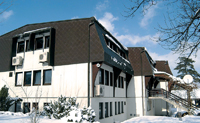
Image courtesy of Petnica Science Center
In this way they are ‘learning through research’. Participants ‘discover’ various facts, relationships, structures or models for themselves, under the supervision of experienced researchers. School curricula cannot keep up with the growth of current scientific knowledge so researchers concentrate on developing a few specific skills: how to observe and access information, evaluate content and credibility and infer consequences and possible meanings.
Petnica Science Center has 15 science and technology programmes (including subjects such as archaeology and astronomy) which consist of a series of seminars. The first seminar (in winter, lasting 7 days) is a chance for students to see Petnica from inside and realise that some school subjects can be learned in unexpected ways. The second seminar (spring, 4-8 days) is dedicated to methodology of research, and concentrates on practical things like measuring, using instruments, drawing graphs and writing short reports. Students then propose a research plan for the summer seminar (lasting 13 days) where they do the majority of their research. (Of course, summer seminars also have a lot of non-science activities like swimming in the lake, camp fires, barbecues and late-night guitar playing.) The fourth seminar (autumn, 4 days) is a chance to improve the drafts of their research papers and to hear some interesting new lectures. The last event in the annual cycle is Petnica Students’ Science Conference (at the beginning of December) at which students present the results of their work and submit text for publication in Petnica Papers (see box). A selection of these papers (in English) is available onlinew1.
Examples of students’ projects
The following oral presentations were given at the Petnica Students’ Science Conference 2006:
- Influence of ultrasound on the electrochemical production of hydrogen on different electrodes (Chemistry)
- Simulation of chaos in an RLD circuit (Electronics)
- Boosted SMRNN: online speech recognition (Computer Science)
- Types of children’s names for typical and atypical concepts (Linguistics)
- Determination of an open cluster age (Astronomy)
- The position of pronominal enclitics in constructions with infinitive (Linguistics)
- Influence of World War II on given names in the Savski Venac municipality (History)
- Numerical simulation of one-dimensional freely evolving granular gas (Physics)
- Relationship between school success, popularity, and status of ‘crammer’ in a group (Psychology)
- Archaeological-historical interpretation of the Vojlovica monastery (Archaeology)
- Relationship between physical characteristics of abstract visual stimuli and their connotative meanings (Psychology)
- New aspects of applying acid-base titrations for ascorbic acid determination (Chemistry)
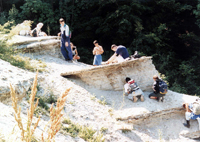
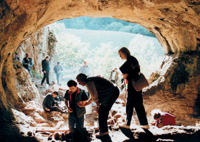
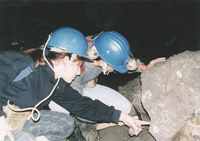
Petnica Students’ Science Conferencew2 is always the last event in the 100-seminar series for secondary-school students every year. It is the culmination of a year’s work with 700 students from 200 secondary schools from Serbia and neighbouring countries, 400 senior associates, professional scientists from 70 university faculties and institutes, 120 junior associates, university students, and a core team of staff from Petnica Science Center. Involvement in the conference usually requires two years of participation in Petnica regular programmes. Submitted papers are in Serbian, but all have summaries in English. Of course, guest participants from other countries present their work in English.
After 2000 programmes had been run in Serbian, Petnica finally started an international science schoolw3 which is run in English and open to secondary-school students both within and outside Serbia (see box). The fact that international students cannot visit Petnica as frequently makes the programme concept quite different. There is no time for endless corrections of research plans, reports and final presentations. Everything should be finished in just two weeks. The basic idea behind such a school is to increase students’ interest in scientific research and to give them the opportunity to practice scientific methodology. In the first two years, students (aged 17-20) from 12 countries attended this programme.
In spite of the distance from their home countries, some of them have already started to come back. The third international school will end before this article goes to press. The fourth will be in August 2008.
Attending the Petnica International Science School
The Petnica International Science School gathers gifted students, unusually motivated for learning through research, from all over the world. The next science school will be in August 2008 and all students aged 17-20 are eligible to apply. Application forms and instructions are available on the Petnica website. The programme fee is €500, but financial support is always available for students from south-eastern Europe.
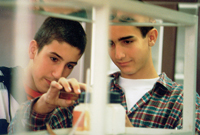
Image courtesy of Petnica Science Center
Although it might seem that a centre like Petnica needs great human and material resources for all these programmes, it doesn’t really require anything more than the proximity to an average-sized university town. There is no need for ‘space-age’ equipment because in order to learn through research it is more important to have stimulating surroundings, a decent library, computing facilities, a few small laboratories where students can work whenever they want and, of course, a group of enthusiastic people willing to share and discuss their interests and ideas. The main problem is trying to encourage people (such as scientists, teachers, officials and sponsors) to participate in an independent project that promotes critical thinking and a passion for science in young people – things that you cannot easily commercialise.
Petnica is particularly proud of the way everyone is frequently encouraged to share ideas, demonstrate new concepts and ‘teach’ younger colleagues. There are programmes for primary-school students, in which the bright instructors are only a few years older than the pupils. Programmes with secondary-school students are enhanced by the participation of university students. All students are encouraged to ask questions and discuss science with others, whatever their age.
There are no teachers and students because everyone learns from each other. We only have more or less experienced researchers.
The centre may have been designed for students, but Petnica is well-known for its specialised courses and workshops for schoolteachers. The centre carries out teacher training for hundreds of science, technology and humanities teachers every year in the same exciting style and by making use of the stimulating environment, which then indirectly influences tens of thousands of students. For teachers, Petnica is a meeting place, a club with a positive atmosphere where their opinion really matters.
Inadequate science education and unenthusiastic public attitudes toward science and technology seem to be problematic all over the world, not just in Serbia. However in developing countries these issues are more prominent because of such effects as the brain drain, limited accessibility of major scientific centres, and old-fashioned equipment and didactic teaching methods. Fortunately, there are some small centres of excellence, such as Petnica, which continue to work hard to break down these barriers preventing the development of budding scientists.
Cecilia (a 17-year-old from Sweden) sent this message after attending Petnica in 2005: “Today I finally managed to do something more than sleeping, eating, looking at photos, and telling my family about how fantastic you [Petnica] are and how much I want to go back (I think they’re quite tired of hearing about you by now…). So, instead I went to see some friends and showed them photos and told THEM how fantastic you are and how much I want to go back…”
Practical details
Petnica Science Center has 30-35 full-time employees. Since it is impossible for such a small number of staff to run so many programmes (130-150 per year), the staff collaborate with hundreds of professional scientists. Junior associates (university students and alumni of Petnica) also have a very special role: over 100 of them volunteer as guides and tutors for their younger colleagues attending the programmes.
The centre is in close contact with 250 secondary schools in Serbia and neighbouring countries in order to keep teachers informed and to encourage them to get their students to apply.
Finally, the cost. Students coming to Petnica for the first time are required to pay a participation fee. If they demonstrate enthusiasm and hard work, the following courses are free of charge. In the past decade many international organisations have supported Petnica programmes, and the centre receives funding from government institutions, industry and an alumni fund.
Contact
For all comments, ideas or questions, or if you want to set up a similar centre in your country, you can contact the staff of the Petnica Science Center by post (Petnica Science Center, P.O. Box 6, 14104 Valjevo, Serbia) or email (pi@psc.ac.yu).
Web References
- w1 – A selection of students’ papers, Learning Physics through Research, is available in English from the Petnica website: http://pi.petnica.rs/
- w2 – For more information on the annual Petnica Students’ Science Conference.
- w3 – The Petnica international programmes website: http://pi.petnica.rs/
Resources
- (2005) Petnica Summer camps. RTD Info – Magazine for European Research Nov: 39
- Majić V (2000) The Petnica Science Center, Science Education Newsletter 152: 1-3. www.britishcouncil.org
- Majić V (2006) Petnica Science Center – Innovative support to gifted students and enthusiastic teachers. IDEASS (Innovation for Development and South-South Cooperation). www.ideassonline.org/pdf/br_40_86.pdf
- Verbić S, Majić V (2002) Petnica Science Center – A Model for an Institution of Extracurricular Science Education. Science Education International 13: 27-29
Review
This article celebrates the success of the Petnica Science Center in Serbia. It is interesting to see how the centre developed and to appreciate the way it has influenced science education in the region. Science beyond the classroom is a vital way to enthuse pupils in science; this article will enable teachers to question facilities in their own country. The Petnica Center models how research can make science come alive for pupils and teachers. (I want to visit!!) This centre is a fantastic resource for science education; it would be wonderful for all pupils to have access to a centre like this. This could be a model for similar centres across Europe. I am looking forward to finding out more about the international conference in August 2008 and will be encouraging local schools to get involved.
Clara Seery, UK





